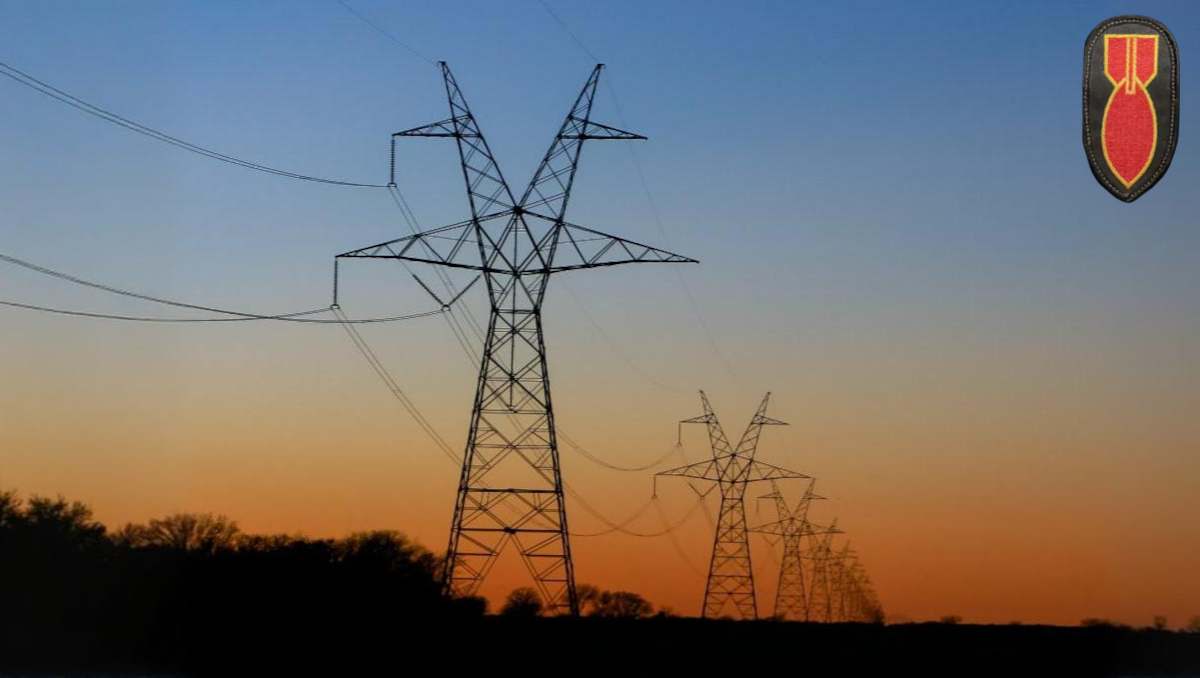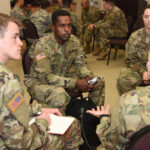
Power generation is the center of gravity for space capabilities, and it is vulnerable to the effects of explosive ordnance, for example, drone delivered bombs.
BOOM! And just like that the enemy has made your lights go out and severed the link between your space-enabled device and constellation of supporting satellites orbiting the Earth.
Power generation is the center of gravity for space capabilities, and it is vulnerable to the effects of explosive ordnance, for example, drone delivered bombs. Without electricity, your space or air defense capability is a brick. The more austere the environment, the greater the risk to the power generation infrastructure. This is why Army explosive ordnance disposal (EOD) needs to train with the Space Force and Air Defense Artillery today, long before Golden Dome, comes online.
Like space literacy, there is a requirement for explosive ordnance literacy and the integration of EOD doctrine with space and air defense doctrine. Where stuff lands matters. On a battlefield operating at the speed of light, two hours of downtime can affect the outcome of a battle. Collection of critical intelligence ceases, directly affecting maneuver in the multidomain fight. If you kill the power generation source or degrade the transmission of energy, there is no electricity for your space or space-enabled device.
The U.S. Space Force’s Space Warfighting A Framework for Planners describes offensive counterspace operations as orbital warfare, space link interdiction (electronic/cyber warfare), and terrestrial strike. Physically attacking space capabilities in orbit (orbital warfare) are high risk due to increased space debris affecting all spacefaring nations. In 2025, mutual assured destruction prevents outright explosive ordnance attacks on orbit as everyone is still living with the aftermath of a 2007 People’s Republic of China (PRC) anti-satellite test. This resulted in a hazardous debris ring of more than 30,000 pieces orbiting the Earth. Terrestrial attacks using explosive ordnance is the most likely threat.
In space, down time is measured in mere nano seconds. Compare this with ground operations. How far can enemy infantry move during a two-hour blackout because a disrupted drone, now unexploded ordnance (UXO), litters a power generation or transmission source for a space capability? The enemy will use explosives because they work, as demonstrated in the Afghanistan and Iraq wars. In the future, explosives will be deployed at a exponentially greater capacity, as seen with the recent Russian attack using 267 drones against Ukraine targets. While Ukraine reported 138 brought down and 119 disappeared, those scattered drones have now created minefields or “dudfields.”
This represents a whole new and unfamiliar set of hazards to ground operations. Army EOD work is extremely high risk and does not operate in a sterile environment. Consider a drone that drops on top of the generator powering a unit’s space or space-enabled capability. An EOD technician cannot approach and treat this problem as an unexploded artillery round. Power generation sites, portable or fixed, have hazards such as electrocution and hazardous materials associated with the production and transmission of power.
Proponents of the Golden Dome argue this will protect the United States energy infrastructure and other external national interests by rendering enemy space operations futile. But this understates where the joint force physically engages enemy targets. Efforts to counter space-based threats may detract from other hazards. In a historical example, on March 10, 1945 an unguided Japanese Fu-go Ballon Bomb with an incendiary and fragmentation explosive ordnance payload came down on a high-power transmission line between generating stations sending an electrical surge to the Hanford production piles, part of the Manhattan Project causing a temporary shutdown of power. However, this event had the potential to cause a strategic materiel delay during World War II. The balloon bomb is not the lesson but the power grid’s vulnerability is.
The Army and Navy are the only service EOD capabilities with colonel/captain-level group commands organized to deal strategically difficult problems; the Navy EOD manpower will literally be stuck in the water clearing ports and bridges leaving the Army with everything above the high-water mark. The power grid is simply too vulnerable to pursue a single solution against one set of hazards. Infrastructure fratricide from poor engagement strategies can turn a quick aerial victory into an unmitigated tragedy. Fast forward 80 years and now these aerial explosive ordnance threats have evolved to have precision guidance systems that mitigate electronic warfare effects. It will be three-dimensional chess keeping the power on and the ones and zeros flowing for space and space-enabled capabilities. Army EOD support to the Space Force and U.S. Space Command (USSPACECOM) is critical to ensuring the energy flows and the communication pipe stays open between the surface and sky—the sensors and shooters.
We may find too late the enemy has made a technology leap because of a risk adverse, BIP, disposal strategy.
War drives innovation. Today, the term du jour is “drone” for unmanned aircraft system (UAS). Tomorrow, it is a localized artificial intelligence autonomous “terminator” operating in three-dimensional space. There will be game changing technologies, like the World War II proximity fuze, for the drone’s guidance system immune to changes or disruptions in the light and electronic spectrum and able to maneuver its payload toward a target while avoiding electromagnetic pulse (EMP) countermeasures. How can warfighters assess that the enemy has employed new capabilities? Rendering safe the explosive ordnance payload will allow guidance system exploitation. If the course of action is to blow-in-place (BIP), the guidance system is a jigsaw puzzle—good luck BIP’ing nano technology and reassembling the fragmentary puzzle! Amateurs cannot come close to the brisance, or crushing effect, of state-manufactured explosives. The next drone war will be a battle to reduce weight while achieving effective kills. We may find too late the enemy has made a technology leap because of a risk adverse, BIP, disposal strategy.
The future problem is when the Golden Dome engages the threat it absolutely must know where its rounds land. The civilian airspace and urban centers of the United States demand this level of confidence. Training, exercising, and integrating all the moving parts of the aerial defense systems, including those elements exploiting the result of the engagements, to protect space architecture is critical to learning and evolving. Excitement about new technology is not a capability.
What goes up must come down. In the future fight against the drone, the “down” has the potential to exacerbate the situation. When pilots eject from a failing aircraft, they do their best to ensure they minimize collateral damage—ride the plane in versus allowing an unmanned craft crash into an occupied structure, neighborhood, or school. Drones and their crash into the ground must limit collateral damage and enable exploitation. Even if the drone does not explode, being hit by 10lbs falling from one hundred feet will hurt.
Consider a hypothetical attempted attack on the container yard of the Port of Long Beach with a drone-transported anti-personnel minefield to degrade port activities. Even if there were air defense capabilities in place and they were able to successfully defeat the attack, there is still a large problem if smashed drone swarm airframes and explosives are scattered payloads all over the Memorial Care Long Beach Medical Center because it was in the avenue of approach. Instead of limiting unexploded explosive ordnance (UXO) to a container yard or preplanned kill zone with limited risk to the human population, the danger is now spread across a densely populated urban environment, necessitating evacuation and disruption of medical care.
It is important for EOD and defending forces to train and integrate today to develop exploitation and disposal strategies. Unfortunately, if EOD is not part of the plan, exploitation that could have informed better ways to interdict future drone or even missile attacks may be unrealized because of the urgency of the moment.
Military EOD brings capability depth. Hopefully, the hypothetical situation outline above demonstrates that EOD should be part of the planning for drone defense, particularly in reference to where we would want damaged airframes and payloads to go. Rendering safe the explosive ordnance threat is the core competency of EOD, and it is the only Department of Defense capability available to mitigate a drone’s explosive payload.
Local bomb squads do not have the capacity for multi-day disposal operations or perhaps the expertise for a multi-explosive ordnance multilocation problem. As for exploitation, law enforcement bomb squads’ approach to evidence collection is oriented toward ensuring a successful prosecution in a court of law, not generating a target list for interdiction. Training with local bomb squads and first responders is essential to increase technical capacity. BOOM! And just like that, your lights are back on, and your device is communicating with its satellite orbiting the Earth because EOD was part of your planning. There was no panic, just another react-to-contact battle drill with a teammate. EOD cleared the way for your support team to reestablish the flow of electricity because they were both integrated into a well-exercised plan. Your commander avoided a mass casualty event because the drones were channeled away from personnel before engagement. Time increased for EOD to exploit the airframes, guidance systems, and explosive payloads. Thus, enabling space and air defense capability evolution and strategic assets to target the enemy’s drone manufacturing and logistics infrastructure.
Frederick L. Corcoran III is a retired U.S. Army lieutenant colonel and Force Management Officer with deployments to Afghanistan, former EOD officer with deployments to Egypt and Kuwait and current Department of the Army Civilian for the U.S. Army Space and Missile Defense Command. He holds a bachelor’s degree in forensic science from Jacksonville State University, an MBA from George Mason University, and a MSS from the U.S. Army War College.
The views expressed in this article are those of the author and do not necessarily reflect those of the U.S. Army War College, the U.S. Army, or the Department of Defense.
Photo Description: Transmission towers at sunset in East Texas
Photo Credit: Matthew T Rader via Wikimedia Commons





A thought-provoking and insightful piece. Integrating EOD into space planning seems more essential than ever
More from an overall perspective, does the below have relevance to the discussion and information provided in our article above?:
“Resilience is roughly defined as the ability to absorb, manage, and recover from crises that will inevitably strike the U.S. and its allies. The logic is simple: countries that can withstand repeated shocks without losing strategic momentum will have an advantage over the long run.
This new perspective reframes geopolitical competition as a contest of endurance rather than just raw power.”
(See the “What is to be Done” section of the May 2, 2025, “Irregular Warfare Initiative” article entitled “Winning Without Fighting: Resilience as National Security Imperative,” by Jacob N. Shapiro.)
A chilling and timely reminder of infrastructure vulnerabilities—excellent analysis.
This is a sobering and critical analysis. The dependence on space-based assets creates a fragility that many people don’t consider. The article does a great job of explaining the cascading effects that a “lights out” scenario would have, not just militarily but on civilian life. It’s a serious call to build resilience and redundancy.
This article was absolutely riveting, and frankly, terrifying. As a civilian, the strategic importance of the electromagnetic spectrum is something I’ve never even thought about. The way the author laid out our military’s dependence on it and the catastrophic consequences of losing control—even for a short time—was a serious wake-up call. The closing call to action for the DoD to adapt is powerful. A must-read.